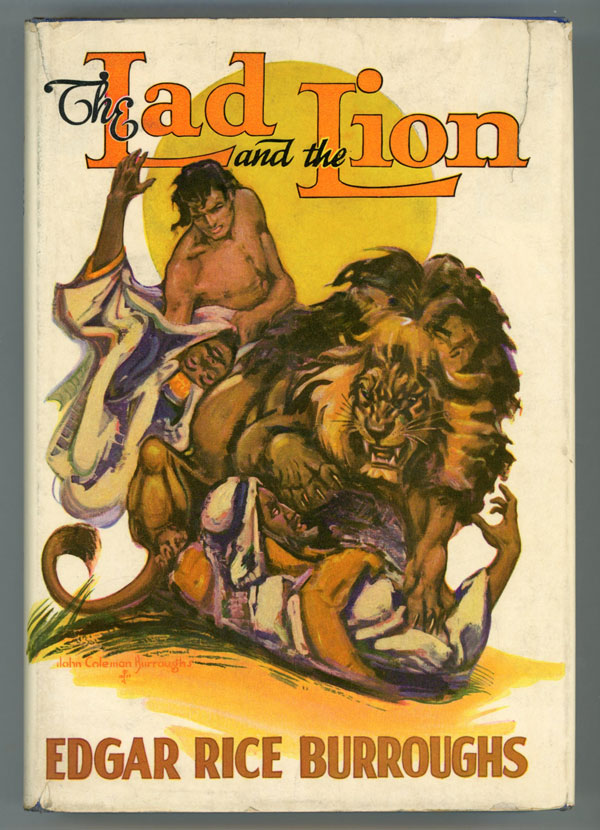Book Review: The Lad and the Lion by Edgar Rice Burroughs
A certain kingdom in Europe is experiencing unrest. The people are chafing under the absolute monarchy, wanting to switch to a constitutional republic. The current king is actually pretty good as monarchs go, but firmly believes that those who have been born and trained to rule should do so, rather than trust to the will of the people and random elections. A group of revolutionaries, soon to be known as “the Terrorists”, have taken advantage of the unrest to make themselves the face of the republican movement. They make a deal with the king’s brother Otto; if the king and his heir Prince Michael suddenly are not alive and Otto attains the throne, he will sign a constitution giving the people more of a voice in government.

The king isn’t a complete fool, and realizes things are about to pop. He has one of his retainers smuggle Prince Michael out of the country. The king is assassinated, and Michael is lost in a shipwreck, presumed dead. Otto takes the throne, and promptly reneges on his promises, having the people he knows to be in the revolutionary party shot instead. King Otto is not as good a ruler as his brother, and the people suffer. Also, his son, Prince Ferdinand, is a royal brat.
Michael is not dead, of course. But he did suffer total amnesia as a result of the shipwreck, and drifted insensible for a while before being taken aboard a derelict ship by a deaf-mute man with a captive lion cub. For several years, the older man uses the lad as a slave as he grows to young manhood and the lion matures.
Eventually the lad and the lion turn against their cruel master, who dies to the lion’s jaws. After some more drifting, the pair abandon ship and wind up in the dry savannah/desert part of Africa. Their adventure is about to truly begin!
This combination of adventure story and political thriller was written by Edgar Rice Burroughs in 1914, first published in magazines in 1917, was turned into a movie that same year (the first of ERB’s novels to do so!) and took until 1938 before being published in book form. According to Wikipedia, it’s believed that Burroughs did another editorial pass for the book version, as certain aspects changed from a 1910s political landscape to a 1930s one.
The story is structured in alternating chapters, with one plot following the lad and the lion as they adapt to life in the wild and then encounter “civilized” humans, with the lad realizing that he is human and falling in love, while the other plot follows the political turmoil in the kingdom he’s left behind.
Good: Exciting action scenes and the romance is not half bad. The ending subverts the usual expectations a reader would have had back in the 1910s.
Less good: Hoo boy, the ableism. The deaf-mute man also suffers from epilepsy, and is described as a “moron” which at the time was a medical term. The narration feels free to call him “a defective” and ascribes his cruelty to his mental disabilities. His horrible death is considered justified.
Arabs are described as being more “primitive” than other races. Not that being “civilized” makes Europeans come off any better in this particular story; the only truly good people are the lad who is basically a bipedal beast for much of the story, and Naklha, the one Arab maiden who surpasses notions of race and class.
Odd: Some characters never get names, most notably “the cobbler’s beautiful daughter” who keeps that description even when she gets married and takes an active role in the plot. Her husband is named, but she doesn’t even get a “Mrs. Wesl.”
Political: The revolutionaries talk about getting a “liberal constitution” a lot, but calling themselves “Terrorists” is a dead giveaway. Most of the ones who lead the movement are most interested in gaining power for themselves.
Content note: Assassination, regular murder, suicide, deaths in combat. (The lad is fine with killing human enemies, but for reasons unknown to himself draws the line at eating them.) Child abuse, animal abuse. Ableism. Racism, ethnic prejudice and classism. Nakhla is repeatedly threatened with slavery and implied sexual assault. Two of the characters are heavily implied to be having extramarital sex.
Overall: This is one of Mr. Burroughs’ more obscure works, and that’s not surprising. The innovative plot structure is the best thing here, and there’s a lot of incidental bits of the story that have aged badly. Recommended for completists, and adventure fans who can handle the outdated attitudes.

